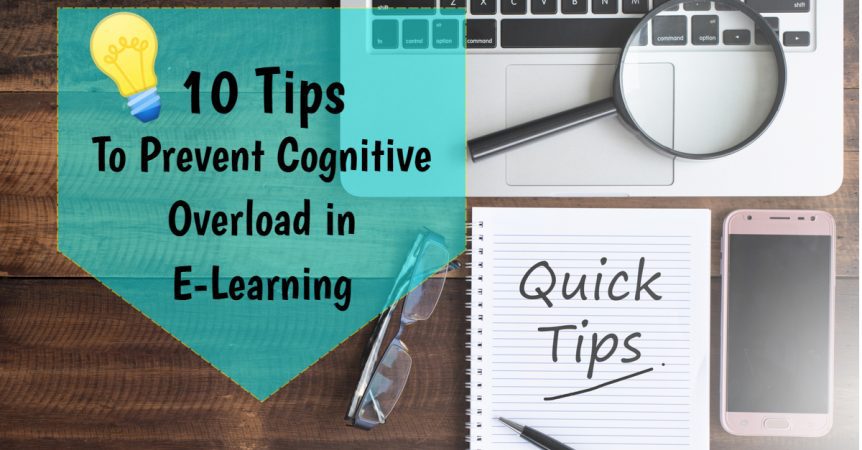10 Tips to Prevent Cognitive Overload in E-Learning
In a previous blog, we explained cognitive load theory and looked at ways to identify if cognitive overload is a problem in your existing e-learning courses. In this blog, we will look at how to prevent cognitive overload from occurring in the first place through e-learning design and strategy.
As a quick recap, cognitive overload is where learners are presented with more information and mental stimulus than their short-term memory can cope with. The result is a reduced capacity to learn.
Preventing Cognitive Overload from Occurring When Designing New E-Learning Courses
Focus on the Topic
One of the best things you can do to prevent cognitive overload is to stay on topic, removing anything that is not relevant. Irrelevant content is a distraction and takes up brain capacity to process. That means less brain capacity for the information that you want to get across, i.e., the information that is important.
Use Conversational Language
Text that is stuffy, formal, technical, and/or jargon-filled will make it harder for learners to follow what you are saying. Also, you don’t want learners having to figure out what a phrase or word means by, for example, going to Google to look it up. The best approach is to use normal, everyday language as this lets the learner focus on the content rather than the text itself.
Embrace White Space
In e-learning, white space is okay as it helps to prevent cognitive overload. This is because filling up spaces with images and other content gives the learner something else to process. The same applies to audio elements such as background sounds and music. Learners will be able to concentrate on the content more if you minimise these features or remove them altogether through white space and silence.
Split Complex Problems into Small Steps
Another common cause of cognitive overload is where learners are presented with complex topics to learn in one go or complex problems to solve. You can alleviate this when deciding on the content structure for your e-learning course by splitting out these complex sections into smaller steps. These smaller steps will be easier to process.
Let Learners Practice
Practice is one of the best ways of getting information from our short-term memory to our long-term memory. Therefore, it makes sense to give learners the opportunity to practice what they have learned before giving them new information to process. This is particularly important for challenging concepts and topics.
Use Microlearning Techniques
Microlearning is a training strategy structured to prevent cognitive overload. It involves presenting information to learners in small, easy-to-process chunks. These chunks usually only contain one new piece of information. The learner can then process that information before moving on to the next section.
Use Various Media
Cognitive overload can also occur when learners are doing the same thing over and over. Reading screen after screen of text is one example. You will help learners process the content of your e-learning course by using various types of media to present new information, reinforce information previously explained, and give learners an opportunity to practice and/or test their knowledge.
Give Learners More Control
Another of the common causes of cognitive overload is pacing, where the e-learning course progresses too fast for the learner to keep up. In this situation, the e-learning course could be moving onto a new topic area while the learner is still trying to grasp what has just been presented. Giving more control to learners, particularly in how quickly they go through the course, will help to alleviate this issue.
Use Intuitive Navigation
The navigation in your e-learning course should be easy and instinctive to use. Brain processing capacity will be used up unnecessarily if the learner has to think about what they need to do next or if they are confused about which button to tap or click. Everything from the navigational structure to the buttons to the menus should be absolutely clear to the point where the learner doesn’t have to think about it.
Communicate with Learners
Some issues with cognitive overload can occur even when you take all the above steps to prevent it from happening. This is because of the nature of e-learning courses, where learners can work through the content in any location and on any device. This is a big benefit of e-learning, but it also presents a potential cognitive overload problem – external distractions.
Social media notifications, messages, and emails can all intrude on e-learning activities. There are also many physical distractions to contend with in typical home, work, or public locations in the UAE and Saudi Arabia. Your options for mitigating this potential problem are limited, but one thing you can do is communicate with learners. You can do this at the very beginning, explaining what the learner can expect from the course, what they will be able to achieve, and how best to work through the content. In the latter point, you can mention the importance of avoiding distractions – silencing notifications, learning in a quiet environment, etc.
Optimising Your E-Learning Course
With the notable exception of the last point, the points in the list above could also be in a list of tips for making your e-learning courses more engaging. Most would also feature on lists about improving the learner experience or enhancing knowledge retention. This is because all these goals – preventing cognitive overload, maximising engagement, improving the learner experience, enhancing knowledge retention – are all intertwined.
In other words, focusing on learners rather than content when creating e-learning courses is a big part of preventing cognitive overload.
